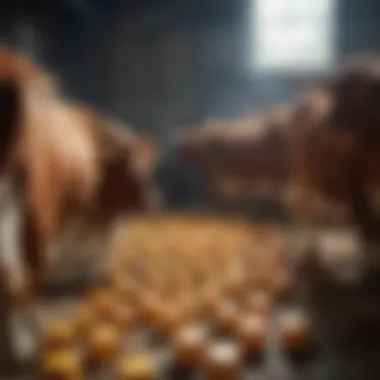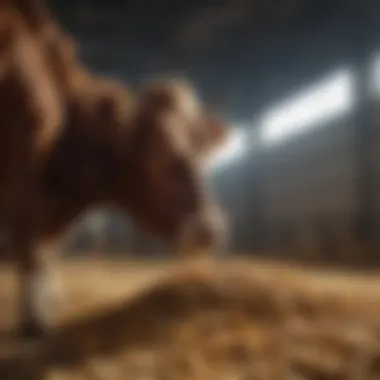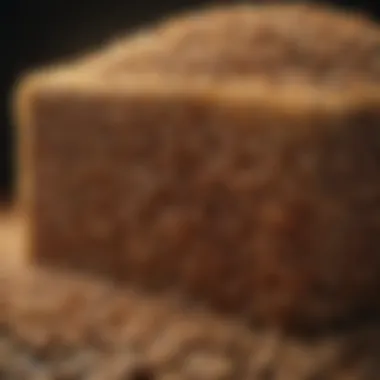Bulk Cattle Cubes for Sale: A Comprehensive Guide


Intro
In the world of livestock management, the choice of feed significantly impacts animal health and productivity. Among the various options available, bulk cattle cubes stand out as a practical solution for cattle nutrition. Understanding these products is crucial for farmers, agronomists, and enthusiasts in the agricultural sector. In this article, we will explore the production process of bulk cattle cubes, their nutritional benefits, and key considerations for purchasing. Our aim is to provide comprehensive insights into their role in modern livestock practices, ensuring that you can make informed decisions.
Research and Data Analysis
Latest Trends in Livestock Nutrition
The livestock industry is witnessing an evolution in feed technology. The production of bulk cattle cubes aligns with growing demands for efficient and nutritious feed options. Research indicates a shift towards high-protein cubes that cater to the specific nutritional needs of cattle, especially during critical growth periods. Farmers now prioritize formulations that enhance weight gain and improve overall health.
Statistical Insights into Feed Efficiency
Recent studies underscore the importance of feed efficiency in cattle production. According to data from various agricultural reports, feed conversion ratios have improved with the adoption of specialized feeds like bulk cattle cubes. This means that cattle can convert feed into body mass more effectively, which is vital for profitability in livestock farming.
Benefits of Bulk Cattle Cubes
The advantages of incorporating bulk cattle cubes into feeding regimens include:
- Nutritional Balance: Formulated to provide essential vitamins and minerals that promote health.
- Convenience: Available in bulk, reducing the need for frequent purchases and storage concerns.
- Cost-Effectiveness: Often more affordable per unit than smaller bags of feed products.
- Improved Palatability: Many formulations are designed to be appealing to cattle, ensuring better intake and digestion.
Role in Livestock Management
Bulk cattle cubes serve as a cornerstone in effective livestock management. Their structured approach to nutrition can assist in regulating the dietary intake of cattle, which is essential in large herds. Additionally, using such products minimizes feed waste, addressing environmental and economic considerations in agriculture.
"Efficient feeding strategies not only improve livestock health but also optimize resource use in agriculture."
Purchasing Considerations
When considering bulk cattle cubes, various factors should be assessed to ensure quality and suitability for your livestock. Key aspects include:
- Nutritional Composition: Review the analysis label that provides details on the nutrient content, including protein, fat, and fiber levels.
- Source and Manufacture: Investigate the supplier's reputation and ensure compliance with industry standards.
- Cost vs. Benefit: Analyze the long-term savings against initial investment to gauge the overall value.
In summary, bulk cattle cubes provide farmers and livestock managers with an effective way to enhance cattle nutrition while promoting health and productivity. Adopting these products can yield significant benefits when managed correctly and paired with adequate husbandry practices.
Prologue to Bulk Cattle Cubes
The topic of bulk cattle cubes is crucial in today's agricultural landscape, serving as a primary source of nutrition for livestock. Understanding the role of these cubes enhances farm management and optimizes cattle health. The significance extends beyond just feeding; it also involves considerations related to efficiency and long-term sustainability.
Understanding Cattle Feed
Feeding cattle effectively is essential for their growth and productivity. The quality of feed directly influences health, milk production, and weight gain. Cattle feed needs to be balanced, containing proteins, carbohydrates, fats, vitamins, and minerals. Bulk cattle cubes serve as a vital point in addressing these nutritional requirements.
There are various forms of cattle feed available. These include hay, silage, and various grains. However, bulk cattle cubes stand out due to their compact nature and nutritional density. They are designed to provide a complete feed solution that meets the specific dietary needs of cattle, facilitating better herd management and feeding practices.
What Are Bulk Cattle Cubes?
Bulk cattle cubes are compressed feed products formulated specifically for cattle. They are crafted from a mixture of various grains, protein sources, vitamins, and minerals. The manufacturing process often involves heating and compressing the ingredients together, resulting in a dense cube shape that reduces waste and ensures ease of handling.
These cubes are usually sold in bulk quantities, making them economically favorable for farmers managing large herds. The uniformity in size facilitates even consumption, reducing the risk of sorting by the animals. Their portability and shelf stability are additional advantages, making it easier to store and transport large amounts.
Understanding bulk cattle cubes is integral for any livestock operation aiming to enhance productivity and feed management, as they provide a reliable and efficient feeding solution.
The Nutritional Composition of Cattle Cubes
The nutritional composition of cattle cubes plays a vital role in livestock management. Understanding what is in these cubes helps farmers and agronomists make informed decisions about cattle diet. Quality nutrition can enhance the health and productivity of livestock, affecting growth rates, milk production, and overall well-being.


Cattle cubes are formulated to meet the specific dietary needs of cattle at different stages of life. The careful selection of ingredients ensures a well-rounded intake of nutrients necessary for growth, reproduction, and maintenance of health.
When selecting cattle cubes, it is critical to examine their nutritional content to ensure they align with feeding objectives. Cows require a mix of different nutrients, which include proteins, carbohydrates, fats, vitamins, and minerals. Selecting high-quality products with well-balanced nutrition is essential for optimal cattle performance.
Key Nutrients in Cattle Cubes
Cattle require several key nutrients which are typically included in the formulation of bulk cattle cubes. These nutrients are crucial for supporting physiological functions and promoting growth. Here are some of the essential nutrients found in many cattle cubes:
- Proteins: Building blocks of muscle and tissue. High-quality sources like soybean meal or alfalfa hay are often included.
- Energy Sources: Comprise carbohydrates and fats, which are important for daily energy needs. Ingredients like corn or molasses provide these energy sources.
- Vitamins and Minerals: Essential for various bodily functions. Vitamins A, D, and E, as well as minerals like calcium and phosphorus, are commonly added to improve overall health and immune function.
- Fiber: Not only assists in digestion but also maintains rumen health. Sources include hay or forage components.
The balance of these nutrients helps ensure that cattle grow efficiently and remain healthy throughout their lifecycle.
Comparing Nutritional Profiles
When comparing nutritional profiles of different bulk cattle cubes, farmers should consider several factors. Nutritional content can vary significantly between brands or types of cubes.
- Ingredient Transparency: Look for products with clear information about ingredient sources. Products that use high-quality ingredients usually offer better nutritional value.
- Guaranteed Analysis: This label indicates the minimum crude protein, fat content, and fiber. Comparing these values can direct a farmer to the more suitable option for their cattle.
- Targeted Formulations: Different cubes might be designed for specific purposes, such as calf starter cubes or cubes for maintenance. Choosing a cube tailored to the life stage of the cattle will yield the best results.
To effectively compare products, using a checklist of these factors is advisable. Ensuring that the cubes meet the specific needs of the livestock will enhance growth rates and productivity over time.
"A well-balanced nutritional profile in cattle cubes can lead to significant improvements in herd performance and health."
Overall, understanding the nutritional composition of cattle cubes is crucial for optimizing livestock health. By choosing the right products, farmers can enhance growth rates, improve feed efficiency, and support the overall well-being of their cattle.
Benefits of Using Bulk Cattle Cubes
The adoption of bulk cattle cubes presents various benefits that are essential for modern livestock management. These advantages enhance efficiency, streamline feeding processes, and promote overall cattle health. For farmers and agricultural enthusiasts, understanding these benefits is critical in making informed decisions about livestock nutrition strategies.
Enhanced Feed Efficiency
Bulk cattle cubes are known to significantly improve feed efficiency for farmers. The nutritional formulation of these cubes ensures that cattle receive an optimal balance of energy, protein, vitamins, and minerals. This results in better digestion and absorption of crucial nutrients, leading to enhanced weight gain and improved milk production.
Research suggests that cattle fed with high-quality cubes tend to maximize their feed intake, resulting in less waste compared to other feed types. This not only conserves resources but also reduces overall feeding costs. For example, efficient feed utilization can lead to a reduction in feed costs by up to 15% for some farms.
Convenience and Handling
The convenience factor when it comes to bulk cattle cubes cannot be overlooked. These cubes are designed for easy handling, which minimizes labor requirements during feeding times. Farmers can store large quantities of the product and feed it to their livestock without needing complex equipment.
In comparison to loose feed, bulk cubes require less space and are easier to transport. This makes it simpler to manage feeding schedules and ensures that animals receive consistent nutrition. Moreover, the uniform size of the cubes promotes a more organized feeding routine, which can lead to improved feeding behaviors among the herd.
Longevity and Storage
One significant advantage of bulk cattle cubes is their longevity. When stored correctly, these cubes maintain their nutritional quality for an extended period. This is particularly important during times of feed scarcity or fluctuating market conditions.
The low moisture content in bulk cubes inhibits mold growth and spoilage, allowing for long-term storage without significant nutrient loss. Farmers can stockpile cubes, ensuring a reliable feeding resource throughout the year. Ultimately, this attribute provides peace of mind, knowing that a consistent and high-quality feed source is readily available regardless of market fluctuations.
"Investing in bulk cattle cubes can transform the nutritional strategy of your herd, thus improving both productivity and sustainability in the agricultural practice."
By carefully considering these benefits, farmers can implement bulk cattle cubes into their feeding strategies, leading to improved cattle performance and overall farm efficiency.
Factors to Consider When Purchasing Bulk Cattle Cubes
When it comes to cattle nutrition, the decision to purchase bulk cattle cubes requires careful consideration. This section provides detailed insights into essential factors that impact your choice. Understanding these aspects will enable you to make informed decisions that enhance livestock health and productivity.
Quality Standards and Certifications


Quality standards are a critical aspect when selecting bulk cattle cubes. These standards ensure that the cattle cubes meet specific nutritional requirements and safety protocols. Always look for products that adhere to regulations set by recognized bodies such as the Association of American Feed Control Officials (AAFCO).
Certifications also play a vital role. They show that the producer has implemented good manufacturing practices and that their products have been tested for quality and safety. Key certifications to consider include:
- USDA Organic: Indicates that the ingredients are grown without synthetic fertilizers or pesticides.
- Non-GMO Project Verified: Ensures that the product does not contain genetically modified organisms.
- ISO Certification: Ensures that the manufacturer meets international quality management standards.
By choosing products from suppliers with proper certifications, you can have greater confidence in the safety and efficacy of the cattle cubes.
Price Considerations
Price is an unavoidable factor in making any purchasing decision. Bulk cattle cubes may vary significantly in cost based on ingredients, nutritional content, and production methods. When evaluating price, consider the following elements:
- Cost per Ton: This metric allows for a direct comparison of different products.
- Nutritional Value: Sometimes, higher-priced products offer better nutrition, potentially leading to improved livestock performance.
- Discounts for Larger Orders: Some suppliers provide significant discounts for bulk orders, which could affect your overall costs.
It is important not to compromise on quality for price alone. A cheaper product might save money initially but could lead to higher long-term feed costs due to less efficient weight gain and health issues in cattle.
Supplier Reliability
The reliability of your supplier is paramount. A dependable supplier ensures consistent availability, quality of product, and timely delivery. Key factors to evaluate supplier reliability include:
- Reputation: Research reviews and feedback from other farmers to gauge their experiences with the supplier. Websites like Reddit or Facebook groups can provide insights.
- Customer Service: Evaluate their responsiveness to inquiries and how they handle issues or concerns.
- Track Record: A supplier with a history of providing quality products over time is often more trustworthy.
Market Trends in Bulk Cattle Cubes
Understanding the market trends in bulk cattle cubes is crucial for anyone involved in livestock management. Awareness of these trends can help farmers make informed purchasing decisions. The cattle cube market is influenced by several factors including pricing dynamics, consumer behavior, and production practices. Recognizing prevailing trends not only assists in strategic planning but also improves the overall efficiency of cattle operations.
Current Pricing Trends
Pricing trends for bulk cattle cubes are essential to understand. These prices fluctuate based on various factors such as supply and demand, production costs, and seasonal variations. Recently, there has been an increase in demand for high-quality cattle feed, leading to a corresponding increase in prices. On the supply side, prices might be affected by the cost of raw materials such as grains and supplements used in cube formulation. Seasonal factors, like drought conditions, can also disrupt supply chains, causing prices to rise.
It is important for farmers to keep tabs on these pricing trends. By doing so, they can better anticipate costs and potentially negotiate better deals with suppliers. Regular market analysis is key to identifying patterns over time, allowing for better budgeting and planning in livestock management.
Consumer Preferences
Consumer preferences play a significant role in shaping the cattle cube market. Farmers are increasingly looking for products that provide high nutritional value while being cost-effective. Many are shifting towards cubes made from organic or sustainably sourced ingredients due to health concerns associated with livestock feed ingredients. This demand leads to the availability of various formulations tailored to specific needs such as growth rates, weight gain, and overall health of the cattle.
Moreover, convenience and the ease of handling are critical for farmers. Products that offer easy storage and feeding methods are becoming more appealing. This shift in consumer preference influences manufacturers to innovate, leading to diverse product offerings in the market.
Ultimately, staying informed about consumer preferences helps farmers select the right products for their cattle. Investing in bulk cattle cubes that align with these preferences can lead to improved livestock performance and profitability.
Sustainable Practices in Cattle Cube Production
Sustainable practices in cattle cube production are increasingly important in today’s agricultural landscape. The significance of sustainability extends beyond ethical farming practices; it directly influences the quality, efficacy, and environmental impact of cattle feed. As the global demand for cattle products increases, sustainable methods ensure that livestock can be raised without depleting natural resources. By integrating sustainable techniques into production processes, manufacturers can enhance the nutritional value of cattle cubes while also contributing positively to the environment.
Sourcing Ingredients Responsibly
The foundation of sustainable cattle cube production begins with sourcing ingredients responsibly. This involves selecting high-quality, nutrient-dense components that are produced under sustainable agricultural practices.
- Local Sourcing: Often, sourcing ingredients from local farmers reduces carbon footprint related to transportation. Moreover, it supports local economies and fosters community relationships.
- Certifications: Ingredients should come from suppliers who hold relevant certifications such as organic, non-GMO, or Grass-Fed. These certifications signal adherence to best farming practices.
- Biodiversity Considerations: Using a variety of ingredients promotes biodiversity within the agricultural ecosystem, which contributes to soil health and sustainability over time. Varied sourcing helps reduce dependency on monocultures, which can lead to soil degradation.
"Responsible sourcing practices play a critical role in the lifecycle of cattle cubes, impacting not just the product quality but also the health of our planet."
Environmental Impact Assessments
Conducting environmental impact assessments (EIAs) is an essential practice in cattle cube production. EIAs help producers understand the short-term and long-term effects of their operations on the environment. By identifying potential adverse effects, producers can modify practices to minimize harm.


- Resource Usage: EIAs evaluate the amount of land, water, and energy necessary for production, guiding adjustments to create more efficient processes.
- Waste Management: Proper assessments promote strategies for waste management, ensuring that by-products do not pollute air or water sources. Recycling or repurposing material can lead to significant waste reduction.
- Long-Term Planning: Assessments help in planning future operations, allowing producers to anticipate challenges and take action to mitigate environmental impacts.
Best Practices for Feeding Cattle with Bulk Cubes
The effective feeding of cattle using bulk cubes is crucial for optimizing their overall health, productivity, and growth. Various factors influence how well cattle respond to this form of feed. Establishing best practices not only enhances nutritional delivery but also aligns with efficient management strategies for livestock.
Feeding Strategies
When incorporating bulk cattle cubes into feeding regimens, it is important to develop tailored feeding strategies. These strategies should consider the specific needs of cattle based on their age, weight, and production goals. Here are some considerations:
- Gradual Introduction: Introducing bulk cubes should be gradual. Start with small amounts to allow cattle to adjust to the new feed. Abrupt changes can lead to digestive issues.
- Balanced Rationing: Bulk cubes should not be the sole feed source. They should complement other feeds to ensure a complete nutrition profile. Include forages and grains as applicable.
- Feeding Frequency: Implementing multiple smaller feedings throughout the day can improve digestion and nutrient absorption. This method helps prevent waste and stimulates appetite.
Monitoring Cattle Health and Performance
Monitoring health and performance is a key aspect of successful cattle management. It can prevent potential issues and ensure that the feeding strategy is effective. Here are important metrics and practices to focus on:
- Regular Health Checks: Conduct consistent physical examinations to assess body condition, weight gain, and any signs of illness.
- Performance Metrics: Track daily weight gain and milk production if applicable. These data points can indicate if the feeding regimen is meeting nutritional needs.
- Behavior Observations: Observing feeding behavior can reveal preferences or aversions, which help adjust feeding strategies effectively.
"An ounce of prevention is worth a pound of cure." This is particularly true in cattle management where proactive monitoring can avoid significant health issues later.
By following best practices in feeding strategies and monitoring health, cattle producers can maximize the effectiveness of bulk cattle cubes in their livestock management. Efficient feeding leads to improved growth rates, better reproductive performance, and a more profitable operation overall.
Challenges in the Cattle Cube Market
The cattle cube market is not without its challenges. Understanding these obstacles is crucial for stakeholders involved in livestock nutrition. Addressing these challenges effectively can lead to better decision-making and ultimately enhance livestock health and productivity. This section explores two main challenges: supply chain disruptions and competition from alternative feed sources.
Supply Chain Disruptions
Supply chain disruptions can significantly affect the availability and pricing of bulk cattle cubes. These disruptions can arise from various factors, including natural disasters, geopolitical tensions, and pandemics. For instance, during the COVID-19 pandemic, many farms faced delays in ingredient delivery and increased transportation costs. This impacted their ability to procure quality cattle cubes at reasonable prices.
Disruptions can lead to the following considerations for farmers and agronomists:
- Increased Costs: When supply chains are interrupted, prices may rise due to scarcity of materials. This affects feed costs directly, leading to possible financial strain.
- Quality Control: In an attempt to maintain production, suppliers may compromise on ingredient quality during shortages. This impacts the nutritional value of the cattle cubes,
- Planning: Farmers must be proactive in their purchasing strategies. Anticipating potential issues can help in mitigating risks associated with supply interruptions.
"Understanding the potential challenges in sourcing cattle cubes is vital for improving resilience in livestock management."
Competition from Alternative Feed Sources
Another notable challenge in the cattle cube market is competition from alternative feed sources. Farmers have a range of options when it comes to feeding their livestock. For example, silage, hay, and meals from other grains can serve as substitutes. This competition can sometimes divert attention and investment away from bulk cattle cubes.
The factors affecting this competition include:
- Nutritional Value: Alternatives may offer comparable or superior nutrition, making them more appealing. For instance, some farmers might choose high-protein options if they yield better growth rates in their cattle.
- Cost Factors: Cost-effectiveness plays a significant role. If alternatives are less expensive and readily available, farmers might lean toward these options, potentially impacting bulk cattle cube sales.
- Market Trends: Shifts in consumer preferences are also essential to monitor. If consumers increasingly prefer cattle raised on alternative feeds, farmers may adapt their practices accordingly.
In summary, the cattle cube market faces significant challenges that require constant vigilance and adaptability. Understanding these challenges aids all involved in making informed decisions to enhance the productivity and health of livestock.
Finale
The conclusion serves as an essential reflection of the entire discussion surrounding bulk cattle cubes, highlighting key insights and their significance. It draws together various elements that impact cattle farming today, reinforcing the need for farmers and agricultural enthusiasts to understand the complexities and benefits of using cattle cubes as a primary feed source.
Future Outlook for Bulk Cattle Cubes
Looking ahead, the future of bulk cattle cubes appears promising yet demanding. Factors such as technological advances in agriculture and increasing consumer awareness regarding sustainability will shape the industry. The demand for high-quality cattle cubes is likely to grow, aligning with trends towards healthier livestock products. Innovations in production methods, including the use of alternative protein sources, such as insects or plant-based components, may emerge.
Farmers should be prepared to adapt to these changes, considering both cost-effectiveness and nutritional value for the animals. Additionally, changes in regulatory frameworks may impact how these products are manufactured and marketed, making ongoing education crucial for those involved in livestock management.
Final Thoughts
In summary, bulk cattle cubes are a critical resource in modern cattle farming. Their nutritional value, convenience, and efficient handling cannot be understated. Cattle cubes support healthier animals, which translates into better productivity on farms.
As the industry evolves, so should practices and perceptions surrounding cattle cubes. Staying informed about market trends, supplier reliability, and changes in agricultural standards will empower farmers to make better decisions. Embracing these insights will not only benefit individual operations but will also contribute to the overall advancement of sustainable cattle farming.















